MGT8077 USQ - Literature Review: Cloud Computing Project Adoption
VerifiedAdded on 2023/06/14
|16
|3399
|292
Literature Review
AI Summary
This literature review examines the organizational compatibility of cloud-based projects, focusing on risks associated with implementation. It identifies potential challenges that may hinder project growth and discusses tools and techniques for successful risk identification and management. The review analyzes whether organizations possess the necessary resources to implement cloud projects effectively, with a proper evaluation of identified risks. Drawing from peer-reviewed articles and journals, the report covers unauthorized data access, vendor knowledge gaps, and legal risks. It recommends risk identification tools like documentation reviews, brainstorming, and SWOT analysis, along with techniques for risk analysis, such as checklist analysis and risk registers, to enhance project management and security. This document is available on Desklib, a platform offering past papers and solved assignments for students.
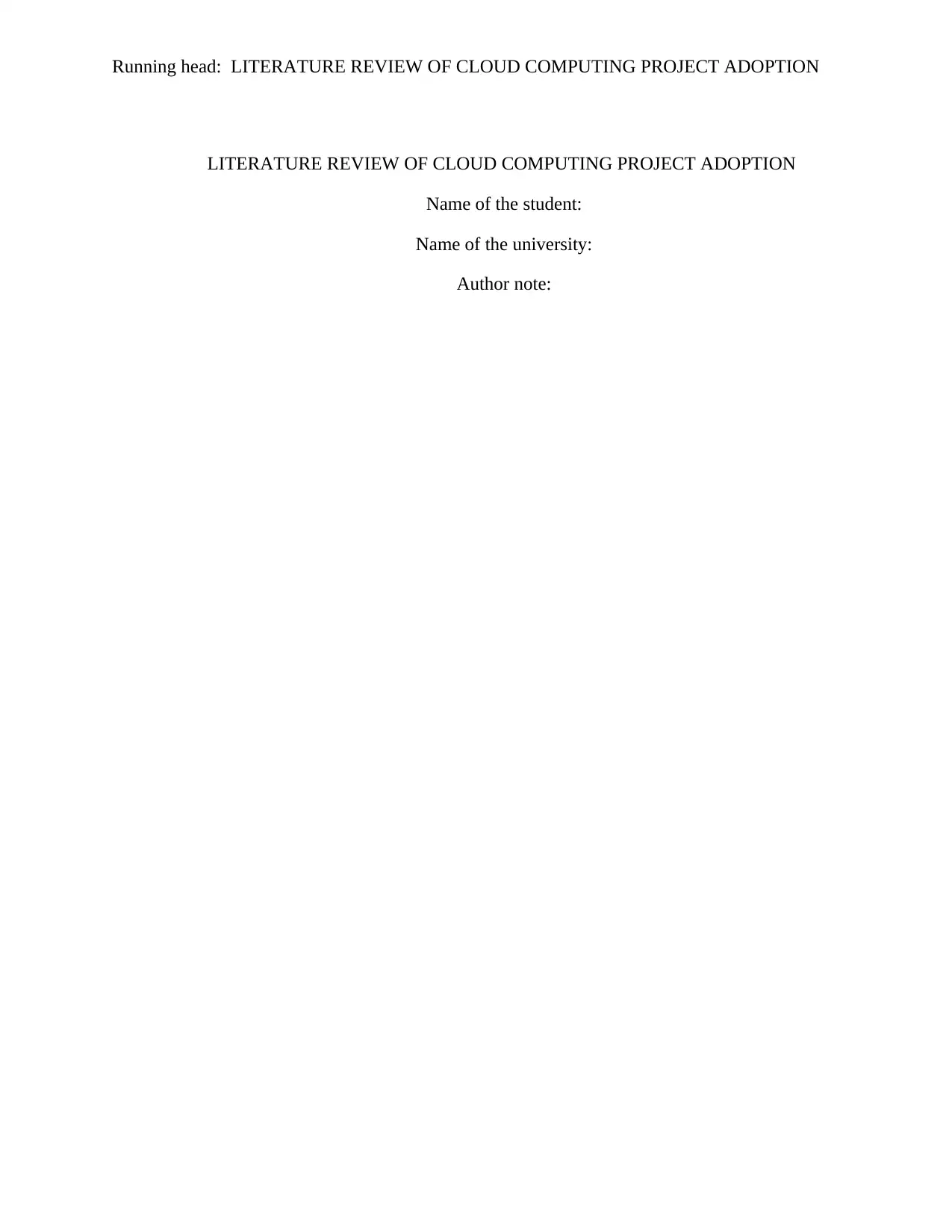
Running head: LITERATURE REVIEW OF CLOUD COMPUTING PROJECT ADOPTION
LITERATURE REVIEW OF CLOUD COMPUTING PROJECT ADOPTION
Name of the student:
Name of the university:
Author note:
LITERATURE REVIEW OF CLOUD COMPUTING PROJECT ADOPTION
Name of the student:
Name of the university:
Author note:
Paraphrase This Document
Need a fresh take? Get an instant paraphrase of this document with our AI Paraphraser
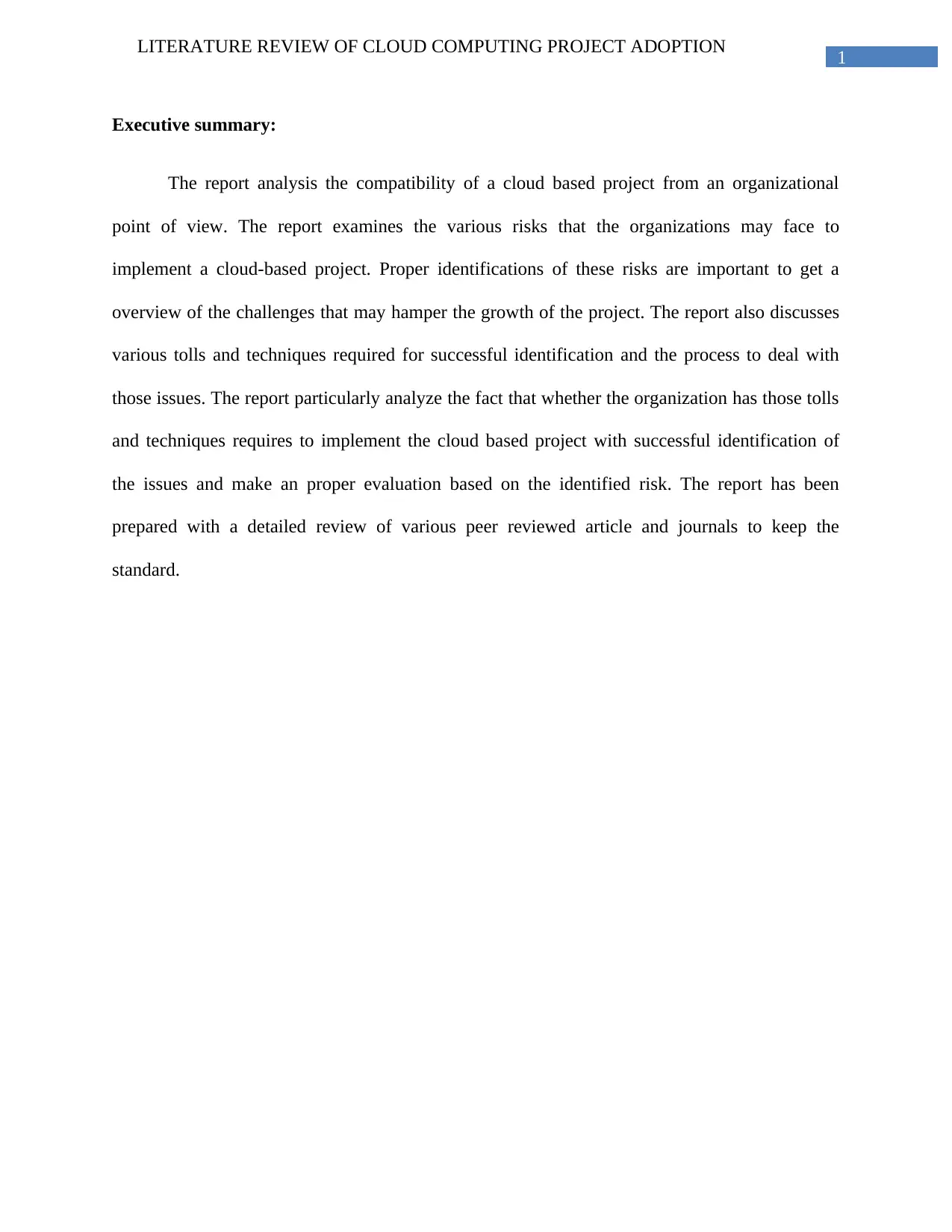
1
LITERATURE REVIEW OF CLOUD COMPUTING PROJECT ADOPTION
Executive summary:
The report analysis the compatibility of a cloud based project from an organizational
point of view. The report examines the various risks that the organizations may face to
implement a cloud-based project. Proper identifications of these risks are important to get a
overview of the challenges that may hamper the growth of the project. The report also discusses
various tolls and techniques required for successful identification and the process to deal with
those issues. The report particularly analyze the fact that whether the organization has those tolls
and techniques requires to implement the cloud based project with successful identification of
the issues and make an proper evaluation based on the identified risk. The report has been
prepared with a detailed review of various peer reviewed article and journals to keep the
standard.
LITERATURE REVIEW OF CLOUD COMPUTING PROJECT ADOPTION
Executive summary:
The report analysis the compatibility of a cloud based project from an organizational
point of view. The report examines the various risks that the organizations may face to
implement a cloud-based project. Proper identifications of these risks are important to get a
overview of the challenges that may hamper the growth of the project. The report also discusses
various tolls and techniques required for successful identification and the process to deal with
those issues. The report particularly analyze the fact that whether the organization has those tolls
and techniques requires to implement the cloud based project with successful identification of
the issues and make an proper evaluation based on the identified risk. The report has been
prepared with a detailed review of various peer reviewed article and journals to keep the
standard.
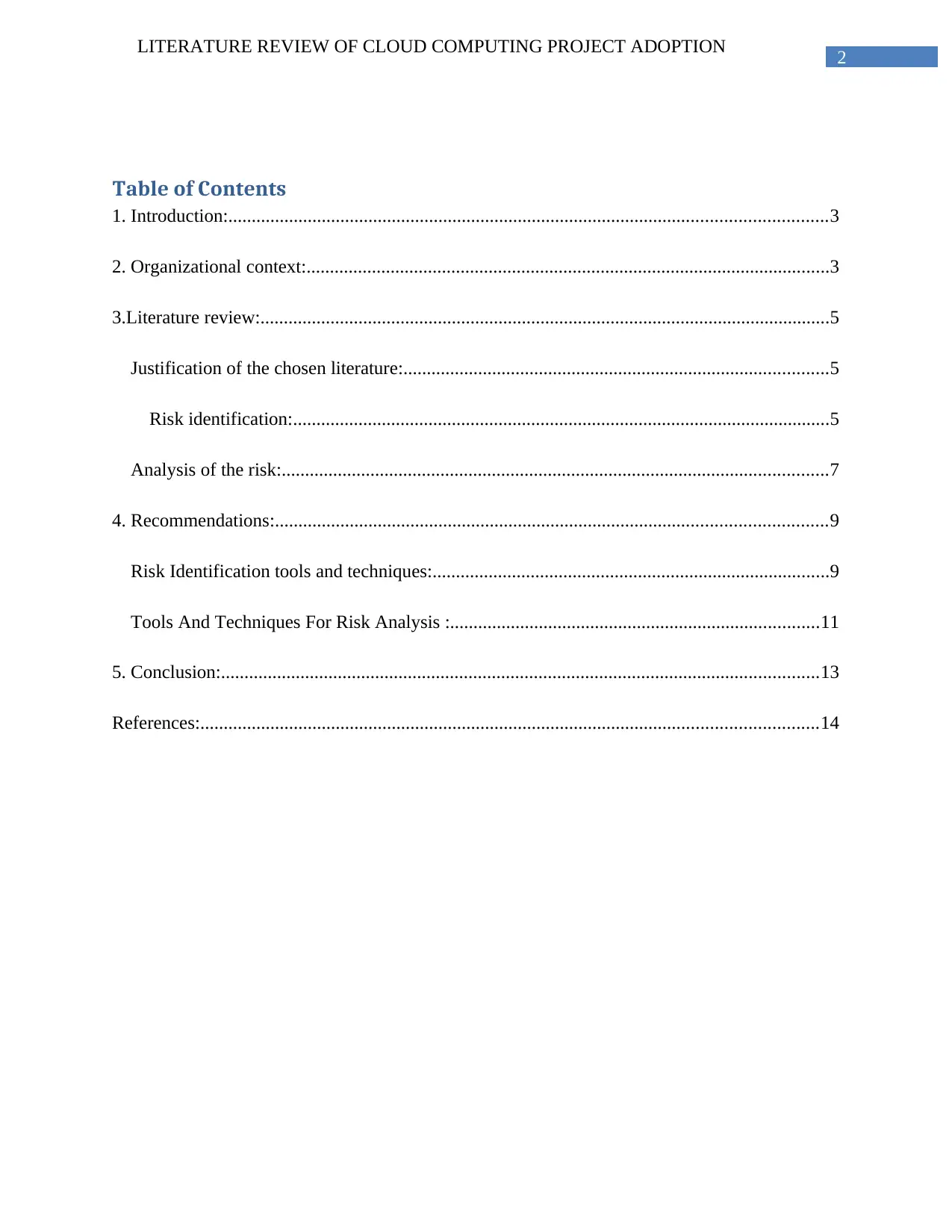
2
LITERATURE REVIEW OF CLOUD COMPUTING PROJECT ADOPTION
Table of Contents
1. Introduction:................................................................................................................................3
2. Organizational context:................................................................................................................3
3.Literature review:..........................................................................................................................5
Justification of the chosen literature:...........................................................................................5
Risk identification:...................................................................................................................5
Analysis of the risk:.....................................................................................................................7
4. Recommendations:......................................................................................................................9
Risk Identification tools and techniques:.....................................................................................9
Tools And Techniques For Risk Analysis :...............................................................................11
5. Conclusion:................................................................................................................................13
References:....................................................................................................................................14
LITERATURE REVIEW OF CLOUD COMPUTING PROJECT ADOPTION
Table of Contents
1. Introduction:................................................................................................................................3
2. Organizational context:................................................................................................................3
3.Literature review:..........................................................................................................................5
Justification of the chosen literature:...........................................................................................5
Risk identification:...................................................................................................................5
Analysis of the risk:.....................................................................................................................7
4. Recommendations:......................................................................................................................9
Risk Identification tools and techniques:.....................................................................................9
Tools And Techniques For Risk Analysis :...............................................................................11
5. Conclusion:................................................................................................................................13
References:....................................................................................................................................14
⊘ This is a preview!⊘
Do you want full access?
Subscribe today to unlock all pages.

Trusted by 1+ million students worldwide
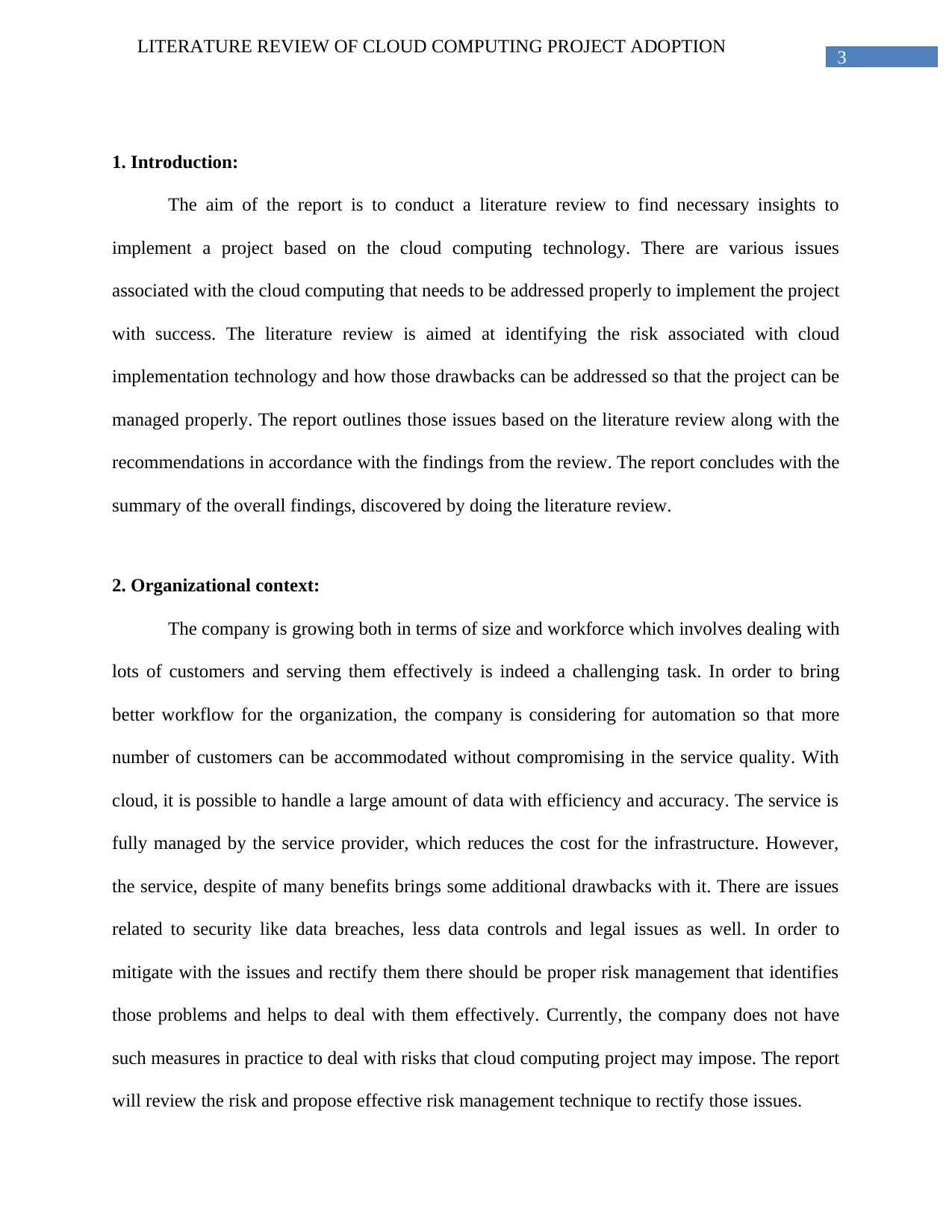
3
LITERATURE REVIEW OF CLOUD COMPUTING PROJECT ADOPTION
1. Introduction:
The aim of the report is to conduct a literature review to find necessary insights to
implement a project based on the cloud computing technology. There are various issues
associated with the cloud computing that needs to be addressed properly to implement the project
with success. The literature review is aimed at identifying the risk associated with cloud
implementation technology and how those drawbacks can be addressed so that the project can be
managed properly. The report outlines those issues based on the literature review along with the
recommendations in accordance with the findings from the review. The report concludes with the
summary of the overall findings, discovered by doing the literature review.
2. Organizational context:
The company is growing both in terms of size and workforce which involves dealing with
lots of customers and serving them effectively is indeed a challenging task. In order to bring
better workflow for the organization, the company is considering for automation so that more
number of customers can be accommodated without compromising in the service quality. With
cloud, it is possible to handle a large amount of data with efficiency and accuracy. The service is
fully managed by the service provider, which reduces the cost for the infrastructure. However,
the service, despite of many benefits brings some additional drawbacks with it. There are issues
related to security like data breaches, less data controls and legal issues as well. In order to
mitigate with the issues and rectify them there should be proper risk management that identifies
those problems and helps to deal with them effectively. Currently, the company does not have
such measures in practice to deal with risks that cloud computing project may impose. The report
will review the risk and propose effective risk management technique to rectify those issues.
LITERATURE REVIEW OF CLOUD COMPUTING PROJECT ADOPTION
1. Introduction:
The aim of the report is to conduct a literature review to find necessary insights to
implement a project based on the cloud computing technology. There are various issues
associated with the cloud computing that needs to be addressed properly to implement the project
with success. The literature review is aimed at identifying the risk associated with cloud
implementation technology and how those drawbacks can be addressed so that the project can be
managed properly. The report outlines those issues based on the literature review along with the
recommendations in accordance with the findings from the review. The report concludes with the
summary of the overall findings, discovered by doing the literature review.
2. Organizational context:
The company is growing both in terms of size and workforce which involves dealing with
lots of customers and serving them effectively is indeed a challenging task. In order to bring
better workflow for the organization, the company is considering for automation so that more
number of customers can be accommodated without compromising in the service quality. With
cloud, it is possible to handle a large amount of data with efficiency and accuracy. The service is
fully managed by the service provider, which reduces the cost for the infrastructure. However,
the service, despite of many benefits brings some additional drawbacks with it. There are issues
related to security like data breaches, less data controls and legal issues as well. In order to
mitigate with the issues and rectify them there should be proper risk management that identifies
those problems and helps to deal with them effectively. Currently, the company does not have
such measures in practice to deal with risks that cloud computing project may impose. The report
will review the risk and propose effective risk management technique to rectify those issues.
Paraphrase This Document
Need a fresh take? Get an instant paraphrase of this document with our AI Paraphraser
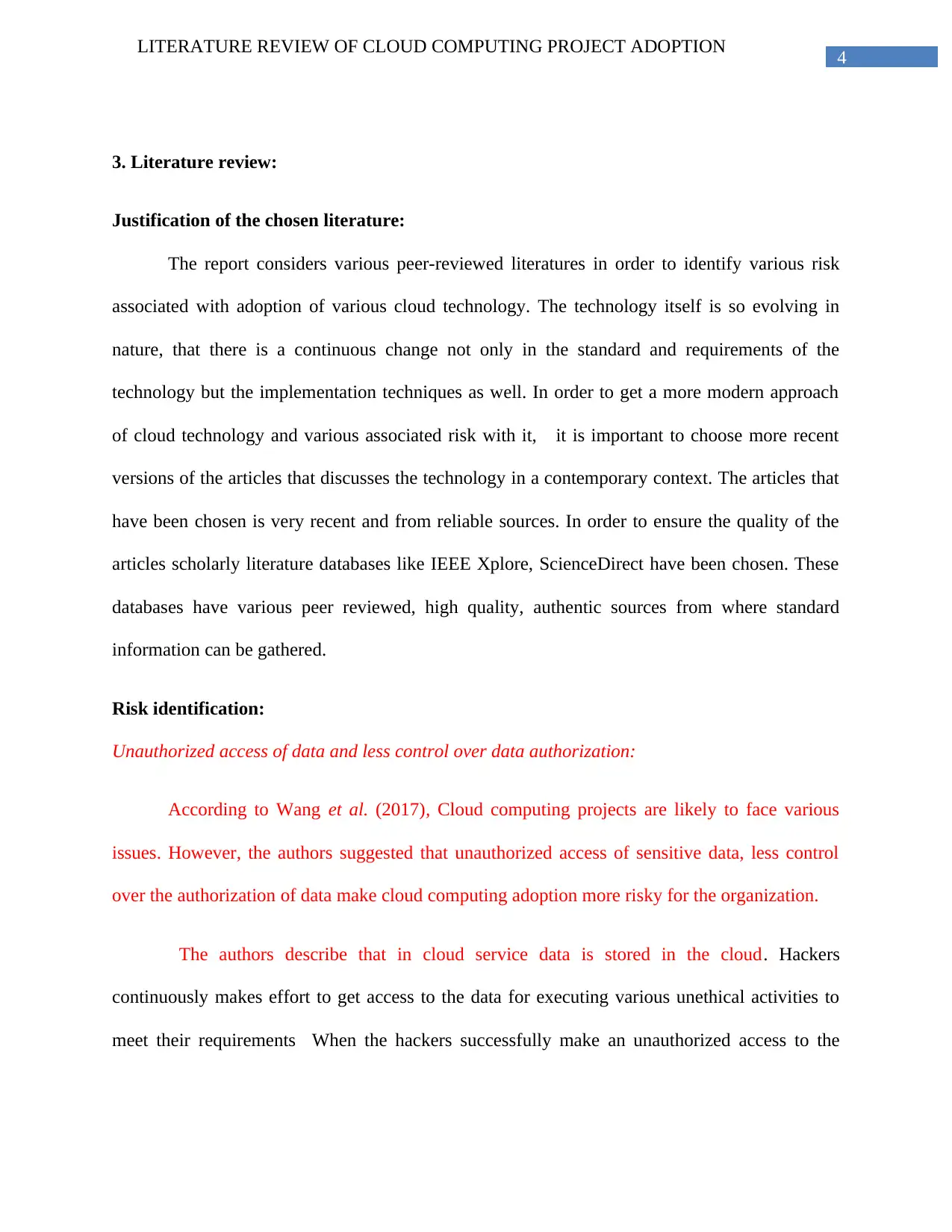
4
LITERATURE REVIEW OF CLOUD COMPUTING PROJECT ADOPTION
3. Literature review:
Justification of the chosen literature:
The report considers various peer-reviewed literatures in order to identify various risk
associated with adoption of various cloud technology. The technology itself is so evolving in
nature, that there is a continuous change not only in the standard and requirements of the
technology but the implementation techniques as well. In order to get a more modern approach
of cloud technology and various associated risk with it, it is important to choose more recent
versions of the articles that discusses the technology in a contemporary context. The articles that
have been chosen is very recent and from reliable sources. In order to ensure the quality of the
articles scholarly literature databases like IEEE Xplore, ScienceDirect have been chosen. These
databases have various peer reviewed, high quality, authentic sources from where standard
information can be gathered.
Risk identification:
Unauthorized access of data and less control over data authorization:
According to Wang et al. (2017), Cloud computing projects are likely to face various
issues. However, the authors suggested that unauthorized access of sensitive data, less control
over the authorization of data make cloud computing adoption more risky for the organization.
The authors describe that in cloud service data is stored in the cloud. Hackers
continuously makes effort to get access to the data for executing various unethical activities to
meet their requirements When the hackers successfully make an unauthorized access to the
LITERATURE REVIEW OF CLOUD COMPUTING PROJECT ADOPTION
3. Literature review:
Justification of the chosen literature:
The report considers various peer-reviewed literatures in order to identify various risk
associated with adoption of various cloud technology. The technology itself is so evolving in
nature, that there is a continuous change not only in the standard and requirements of the
technology but the implementation techniques as well. In order to get a more modern approach
of cloud technology and various associated risk with it, it is important to choose more recent
versions of the articles that discusses the technology in a contemporary context. The articles that
have been chosen is very recent and from reliable sources. In order to ensure the quality of the
articles scholarly literature databases like IEEE Xplore, ScienceDirect have been chosen. These
databases have various peer reviewed, high quality, authentic sources from where standard
information can be gathered.
Risk identification:
Unauthorized access of data and less control over data authorization:
According to Wang et al. (2017), Cloud computing projects are likely to face various
issues. However, the authors suggested that unauthorized access of sensitive data, less control
over the authorization of data make cloud computing adoption more risky for the organization.
The authors describe that in cloud service data is stored in the cloud. Hackers
continuously makes effort to get access to the data for executing various unethical activities to
meet their requirements When the hackers successfully make an unauthorized access to the
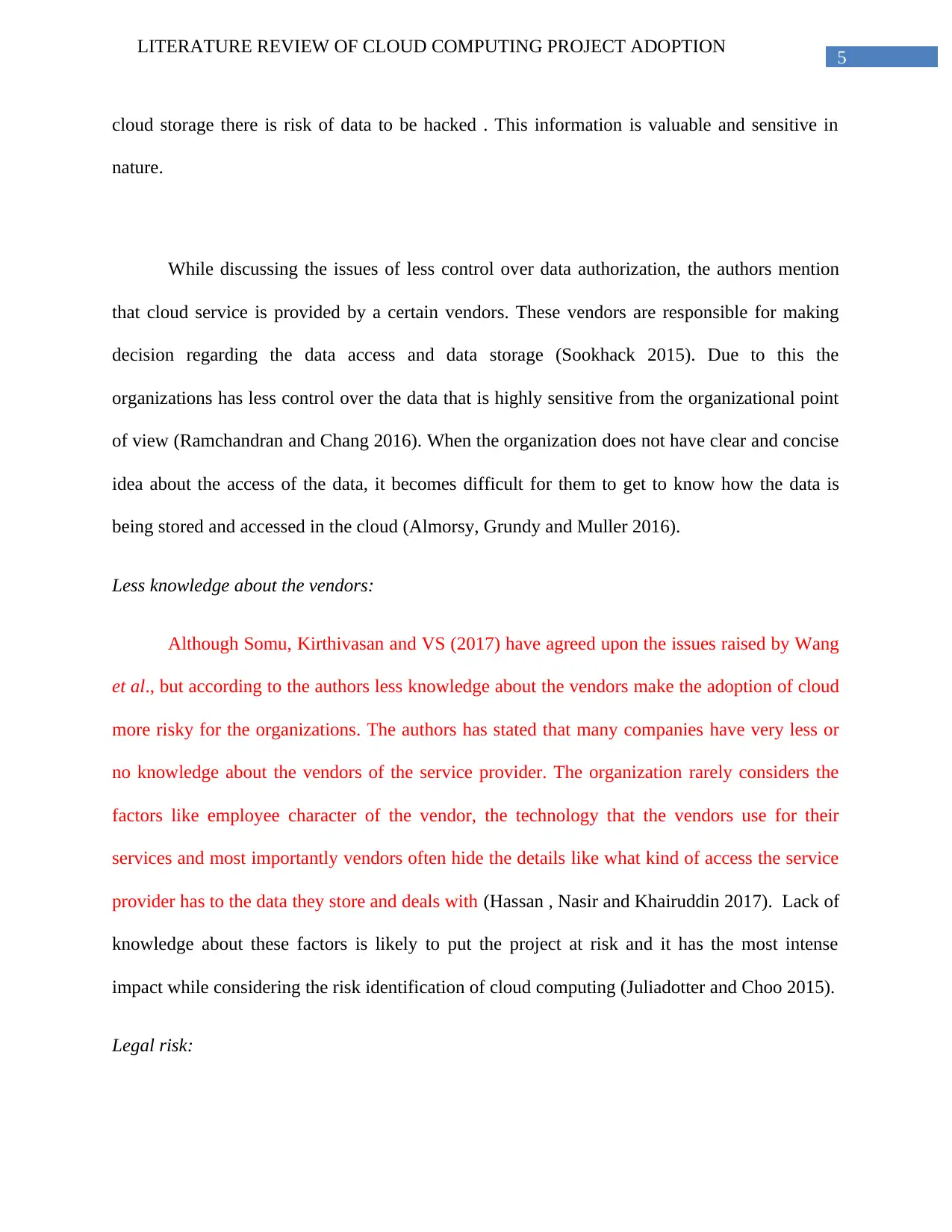
5
LITERATURE REVIEW OF CLOUD COMPUTING PROJECT ADOPTION
cloud storage there is risk of data to be hacked . This information is valuable and sensitive in
nature.
While discussing the issues of less control over data authorization, the authors mention
that cloud service is provided by a certain vendors. These vendors are responsible for making
decision regarding the data access and data storage (Sookhack 2015). Due to this the
organizations has less control over the data that is highly sensitive from the organizational point
of view (Ramchandran and Chang 2016). When the organization does not have clear and concise
idea about the access of the data, it becomes difficult for them to get to know how the data is
being stored and accessed in the cloud (Almorsy, Grundy and Muller 2016).
Less knowledge about the vendors:
Although Somu, Kirthivasan and VS (2017) have agreed upon the issues raised by Wang
et al., but according to the authors less knowledge about the vendors make the adoption of cloud
more risky for the organizations. The authors has stated that many companies have very less or
no knowledge about the vendors of the service provider. The organization rarely considers the
factors like employee character of the vendor, the technology that the vendors use for their
services and most importantly vendors often hide the details like what kind of access the service
provider has to the data they store and deals with (Hassan , Nasir and Khairuddin 2017). Lack of
knowledge about these factors is likely to put the project at risk and it has the most intense
impact while considering the risk identification of cloud computing (Juliadotter and Choo 2015).
Legal risk:
LITERATURE REVIEW OF CLOUD COMPUTING PROJECT ADOPTION
cloud storage there is risk of data to be hacked . This information is valuable and sensitive in
nature.
While discussing the issues of less control over data authorization, the authors mention
that cloud service is provided by a certain vendors. These vendors are responsible for making
decision regarding the data access and data storage (Sookhack 2015). Due to this the
organizations has less control over the data that is highly sensitive from the organizational point
of view (Ramchandran and Chang 2016). When the organization does not have clear and concise
idea about the access of the data, it becomes difficult for them to get to know how the data is
being stored and accessed in the cloud (Almorsy, Grundy and Muller 2016).
Less knowledge about the vendors:
Although Somu, Kirthivasan and VS (2017) have agreed upon the issues raised by Wang
et al., but according to the authors less knowledge about the vendors make the adoption of cloud
more risky for the organizations. The authors has stated that many companies have very less or
no knowledge about the vendors of the service provider. The organization rarely considers the
factors like employee character of the vendor, the technology that the vendors use for their
services and most importantly vendors often hide the details like what kind of access the service
provider has to the data they store and deals with (Hassan , Nasir and Khairuddin 2017). Lack of
knowledge about these factors is likely to put the project at risk and it has the most intense
impact while considering the risk identification of cloud computing (Juliadotter and Choo 2015).
Legal risk:
⊘ This is a preview!⊘
Do you want full access?
Subscribe today to unlock all pages.

Trusted by 1+ million students worldwide
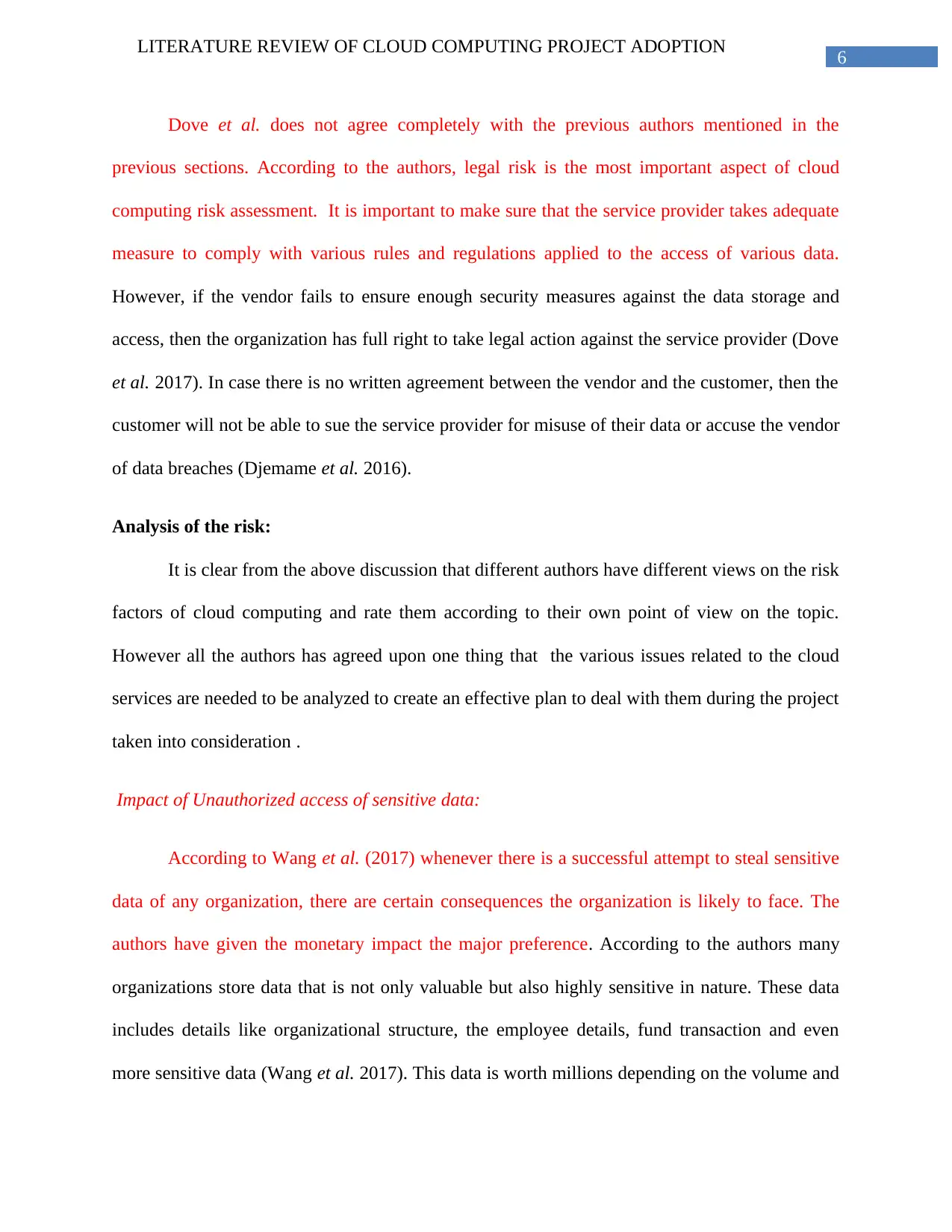
6
LITERATURE REVIEW OF CLOUD COMPUTING PROJECT ADOPTION
Dove et al. does not agree completely with the previous authors mentioned in the
previous sections. According to the authors, legal risk is the most important aspect of cloud
computing risk assessment. It is important to make sure that the service provider takes adequate
measure to comply with various rules and regulations applied to the access of various data.
However, if the vendor fails to ensure enough security measures against the data storage and
access, then the organization has full right to take legal action against the service provider (Dove
et al. 2017). In case there is no written agreement between the vendor and the customer, then the
customer will not be able to sue the service provider for misuse of their data or accuse the vendor
of data breaches (Djemame et al. 2016).
Analysis of the risk:
It is clear from the above discussion that different authors have different views on the risk
factors of cloud computing and rate them according to their own point of view on the topic.
However all the authors has agreed upon one thing that the various issues related to the cloud
services are needed to be analyzed to create an effective plan to deal with them during the project
taken into consideration .
Impact of Unauthorized access of sensitive data:
According to Wang et al. (2017) whenever there is a successful attempt to steal sensitive
data of any organization, there are certain consequences the organization is likely to face. The
authors have given the monetary impact the major preference. According to the authors many
organizations store data that is not only valuable but also highly sensitive in nature. These data
includes details like organizational structure, the employee details, fund transaction and even
more sensitive data (Wang et al. 2017). This data is worth millions depending on the volume and
LITERATURE REVIEW OF CLOUD COMPUTING PROJECT ADOPTION
Dove et al. does not agree completely with the previous authors mentioned in the
previous sections. According to the authors, legal risk is the most important aspect of cloud
computing risk assessment. It is important to make sure that the service provider takes adequate
measure to comply with various rules and regulations applied to the access of various data.
However, if the vendor fails to ensure enough security measures against the data storage and
access, then the organization has full right to take legal action against the service provider (Dove
et al. 2017). In case there is no written agreement between the vendor and the customer, then the
customer will not be able to sue the service provider for misuse of their data or accuse the vendor
of data breaches (Djemame et al. 2016).
Analysis of the risk:
It is clear from the above discussion that different authors have different views on the risk
factors of cloud computing and rate them according to their own point of view on the topic.
However all the authors has agreed upon one thing that the various issues related to the cloud
services are needed to be analyzed to create an effective plan to deal with them during the project
taken into consideration .
Impact of Unauthorized access of sensitive data:
According to Wang et al. (2017) whenever there is a successful attempt to steal sensitive
data of any organization, there are certain consequences the organization is likely to face. The
authors have given the monetary impact the major preference. According to the authors many
organizations store data that is not only valuable but also highly sensitive in nature. These data
includes details like organizational structure, the employee details, fund transaction and even
more sensitive data (Wang et al. 2017). This data is worth millions depending on the volume and
Paraphrase This Document
Need a fresh take? Get an instant paraphrase of this document with our AI Paraphraser
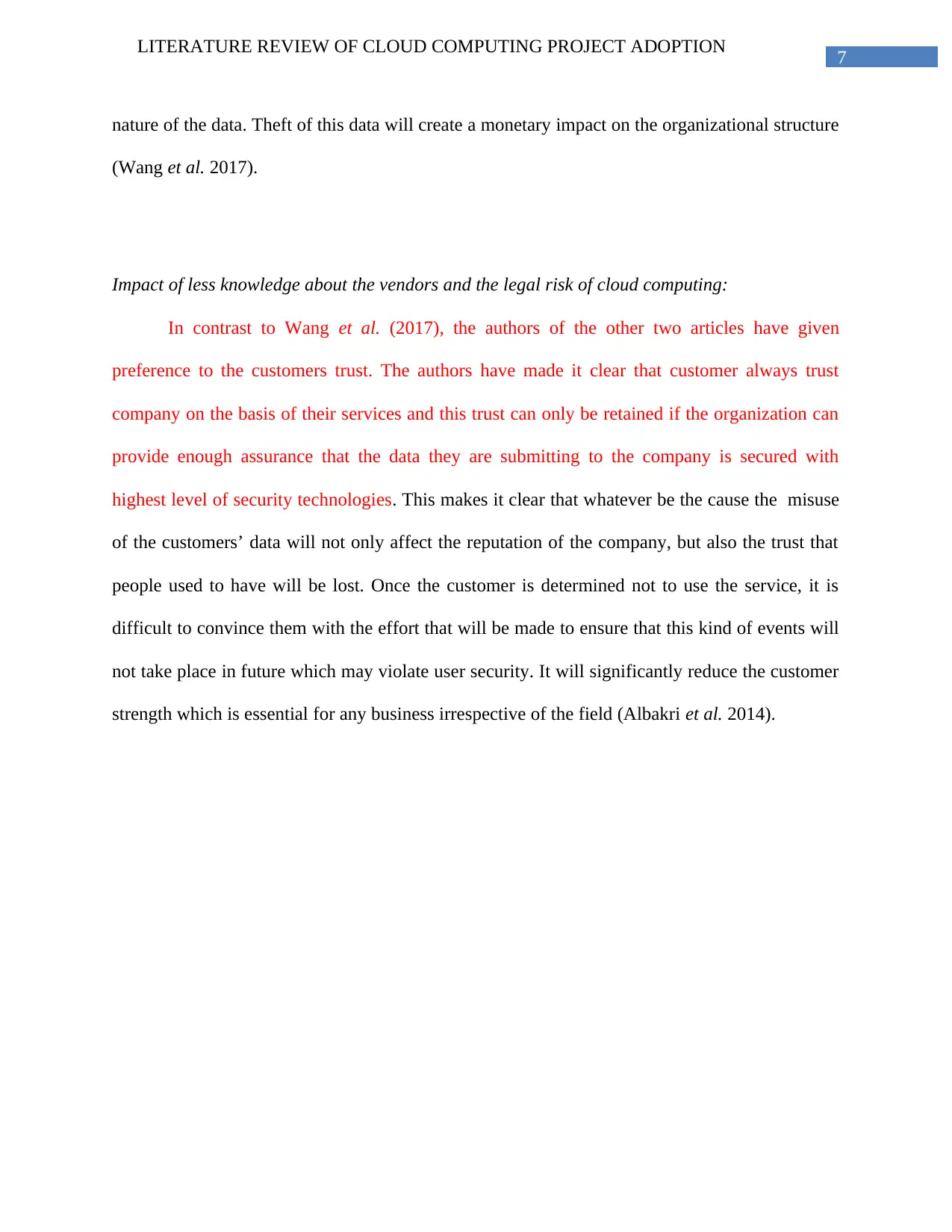
7
LITERATURE REVIEW OF CLOUD COMPUTING PROJECT ADOPTION
nature of the data. Theft of this data will create a monetary impact on the organizational structure
(Wang et al. 2017).
Impact of less knowledge about the vendors and the legal risk of cloud computing:
In contrast to Wang et al. (2017), the authors of the other two articles have given
preference to the customers trust. The authors have made it clear that customer always trust
company on the basis of their services and this trust can only be retained if the organization can
provide enough assurance that the data they are submitting to the company is secured with
highest level of security technologies. This makes it clear that whatever be the cause the misuse
of the customers’ data will not only affect the reputation of the company, but also the trust that
people used to have will be lost. Once the customer is determined not to use the service, it is
difficult to convince them with the effort that will be made to ensure that this kind of events will
not take place in future which may violate user security. It will significantly reduce the customer
strength which is essential for any business irrespective of the field (Albakri et al. 2014).
LITERATURE REVIEW OF CLOUD COMPUTING PROJECT ADOPTION
nature of the data. Theft of this data will create a monetary impact on the organizational structure
(Wang et al. 2017).
Impact of less knowledge about the vendors and the legal risk of cloud computing:
In contrast to Wang et al. (2017), the authors of the other two articles have given
preference to the customers trust. The authors have made it clear that customer always trust
company on the basis of their services and this trust can only be retained if the organization can
provide enough assurance that the data they are submitting to the company is secured with
highest level of security technologies. This makes it clear that whatever be the cause the misuse
of the customers’ data will not only affect the reputation of the company, but also the trust that
people used to have will be lost. Once the customer is determined not to use the service, it is
difficult to convince them with the effort that will be made to ensure that this kind of events will
not take place in future which may violate user security. It will significantly reduce the customer
strength which is essential for any business irrespective of the field (Albakri et al. 2014).
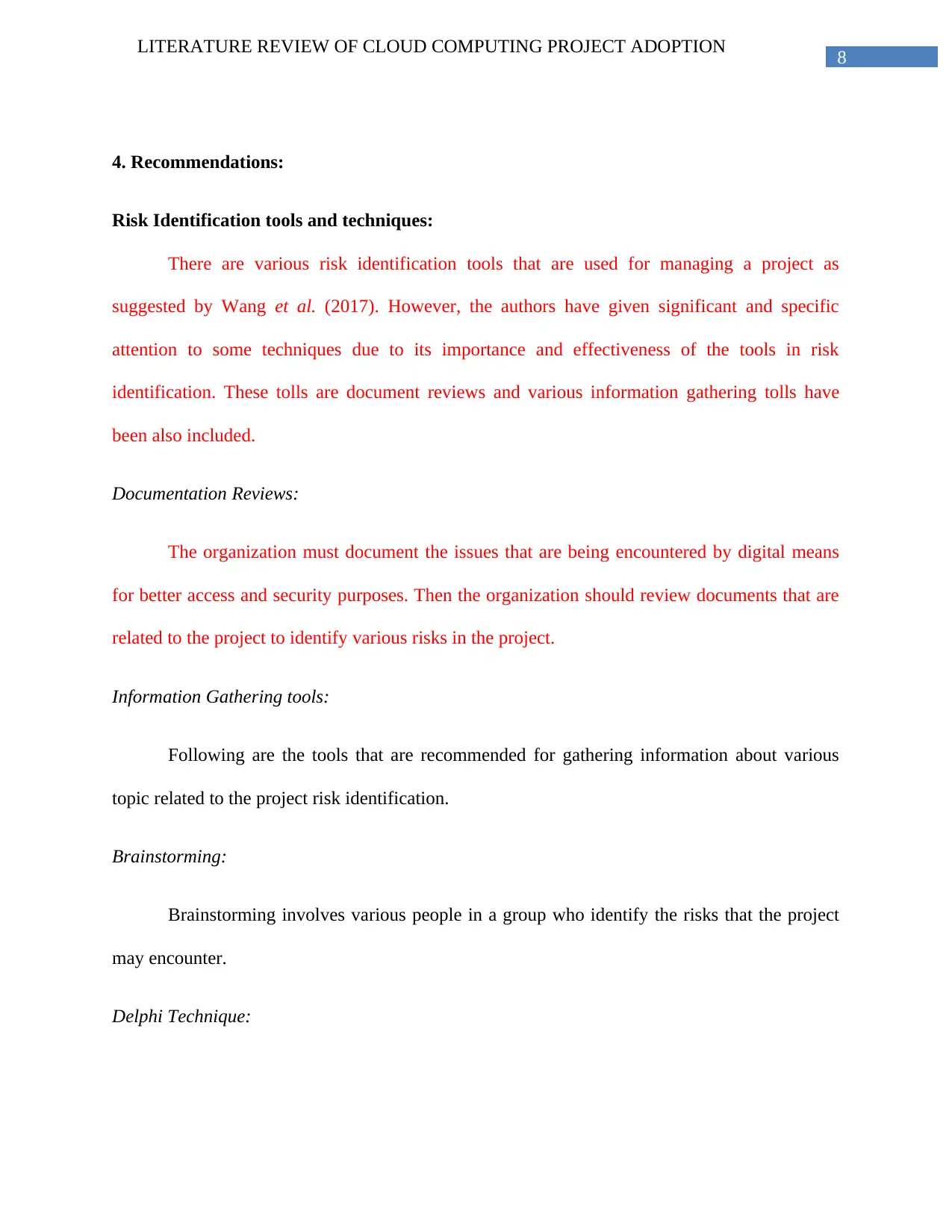
8
LITERATURE REVIEW OF CLOUD COMPUTING PROJECT ADOPTION
4. Recommendations:
Risk Identification tools and techniques:
There are various risk identification tools that are used for managing a project as
suggested by Wang et al. (2017). However, the authors have given significant and specific
attention to some techniques due to its importance and effectiveness of the tools in risk
identification. These tolls are document reviews and various information gathering tolls have
been also included.
Documentation Reviews:
The organization must document the issues that are being encountered by digital means
for better access and security purposes. Then the organization should review documents that are
related to the project to identify various risks in the project.
Information Gathering tools:
Following are the tools that are recommended for gathering information about various
topic related to the project risk identification.
Brainstorming:
Brainstorming involves various people in a group who identify the risks that the project
may encounter.
Delphi Technique:
LITERATURE REVIEW OF CLOUD COMPUTING PROJECT ADOPTION
4. Recommendations:
Risk Identification tools and techniques:
There are various risk identification tools that are used for managing a project as
suggested by Wang et al. (2017). However, the authors have given significant and specific
attention to some techniques due to its importance and effectiveness of the tools in risk
identification. These tolls are document reviews and various information gathering tolls have
been also included.
Documentation Reviews:
The organization must document the issues that are being encountered by digital means
for better access and security purposes. Then the organization should review documents that are
related to the project to identify various risks in the project.
Information Gathering tools:
Following are the tools that are recommended for gathering information about various
topic related to the project risk identification.
Brainstorming:
Brainstorming involves various people in a group who identify the risks that the project
may encounter.
Delphi Technique:
⊘ This is a preview!⊘
Do you want full access?
Subscribe today to unlock all pages.

Trusted by 1+ million students worldwide
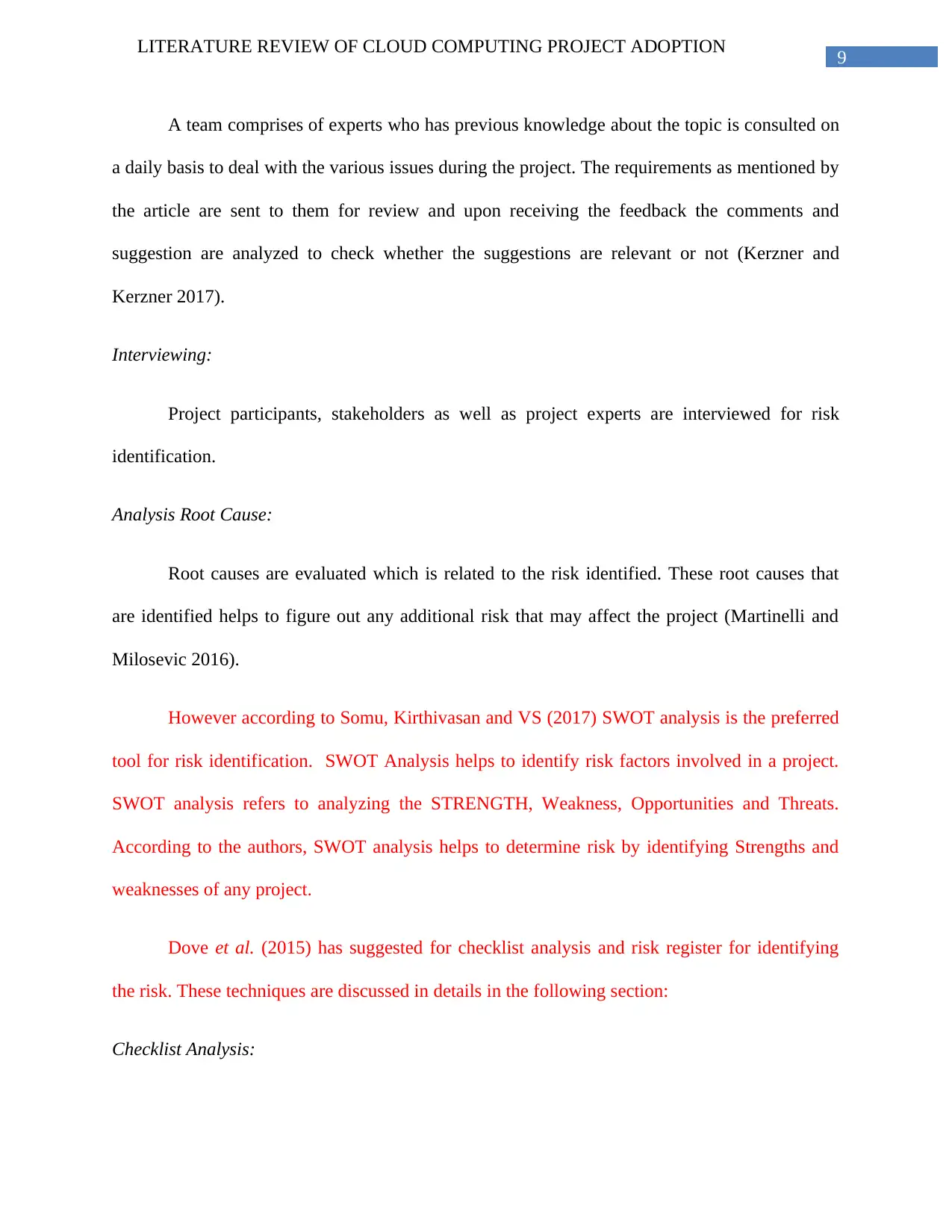
9
LITERATURE REVIEW OF CLOUD COMPUTING PROJECT ADOPTION
A team comprises of experts who has previous knowledge about the topic is consulted on
a daily basis to deal with the various issues during the project. The requirements as mentioned by
the article are sent to them for review and upon receiving the feedback the comments and
suggestion are analyzed to check whether the suggestions are relevant or not (Kerzner and
Kerzner 2017).
Interviewing:
Project participants, stakeholders as well as project experts are interviewed for risk
identification.
Analysis Root Cause:
Root causes are evaluated which is related to the risk identified. These root causes that
are identified helps to figure out any additional risk that may affect the project (Martinelli and
Milosevic 2016).
However according to Somu, Kirthivasan and VS (2017) SWOT analysis is the preferred
tool for risk identification. SWOT Analysis helps to identify risk factors involved in a project.
SWOT analysis refers to analyzing the STRENGTH, Weakness, Opportunities and Threats.
According to the authors, SWOT analysis helps to determine risk by identifying Strengths and
weaknesses of any project.
Dove et al. (2015) has suggested for checklist analysis and risk register for identifying
the risk. These techniques are discussed in details in the following section:
Checklist Analysis:
LITERATURE REVIEW OF CLOUD COMPUTING PROJECT ADOPTION
A team comprises of experts who has previous knowledge about the topic is consulted on
a daily basis to deal with the various issues during the project. The requirements as mentioned by
the article are sent to them for review and upon receiving the feedback the comments and
suggestion are analyzed to check whether the suggestions are relevant or not (Kerzner and
Kerzner 2017).
Interviewing:
Project participants, stakeholders as well as project experts are interviewed for risk
identification.
Analysis Root Cause:
Root causes are evaluated which is related to the risk identified. These root causes that
are identified helps to figure out any additional risk that may affect the project (Martinelli and
Milosevic 2016).
However according to Somu, Kirthivasan and VS (2017) SWOT analysis is the preferred
tool for risk identification. SWOT Analysis helps to identify risk factors involved in a project.
SWOT analysis refers to analyzing the STRENGTH, Weakness, Opportunities and Threats.
According to the authors, SWOT analysis helps to determine risk by identifying Strengths and
weaknesses of any project.
Dove et al. (2015) has suggested for checklist analysis and risk register for identifying
the risk. These techniques are discussed in details in the following section:
Checklist Analysis:
Paraphrase This Document
Need a fresh take? Get an instant paraphrase of this document with our AI Paraphraser
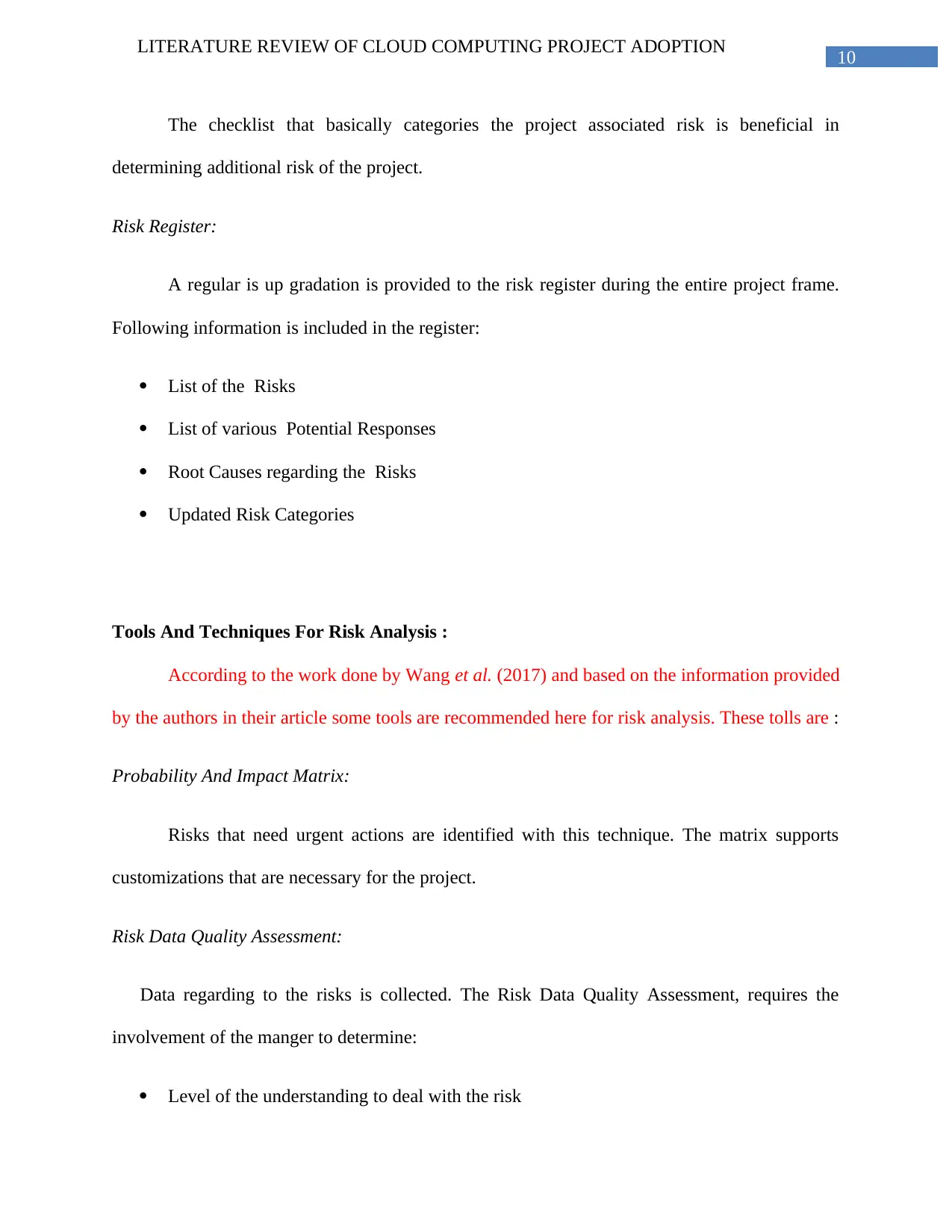
10
LITERATURE REVIEW OF CLOUD COMPUTING PROJECT ADOPTION
The checklist that basically categories the project associated risk is beneficial in
determining additional risk of the project.
Risk Register:
A regular is up gradation is provided to the risk register during the entire project frame.
Following information is included in the register:
List of the Risks
List of various Potential Responses
Root Causes regarding the Risks
Updated Risk Categories
Tools And Techniques For Risk Analysis :
According to the work done by Wang et al. (2017) and based on the information provided
by the authors in their article some tools are recommended here for risk analysis. These tolls are :
Probability And Impact Matrix:
Risks that need urgent actions are identified with this technique. The matrix supports
customizations that are necessary for the project.
Risk Data Quality Assessment:
Data regarding to the risks is collected. The Risk Data Quality Assessment, requires the
involvement of the manger to determine:
Level of the understanding to deal with the risk
LITERATURE REVIEW OF CLOUD COMPUTING PROJECT ADOPTION
The checklist that basically categories the project associated risk is beneficial in
determining additional risk of the project.
Risk Register:
A regular is up gradation is provided to the risk register during the entire project frame.
Following information is included in the register:
List of the Risks
List of various Potential Responses
Root Causes regarding the Risks
Updated Risk Categories
Tools And Techniques For Risk Analysis :
According to the work done by Wang et al. (2017) and based on the information provided
by the authors in their article some tools are recommended here for risk analysis. These tolls are :
Probability And Impact Matrix:
Risks that need urgent actions are identified with this technique. The matrix supports
customizations that are necessary for the project.
Risk Data Quality Assessment:
Data regarding to the risks is collected. The Risk Data Quality Assessment, requires the
involvement of the manger to determine:
Level of the understanding to deal with the risk
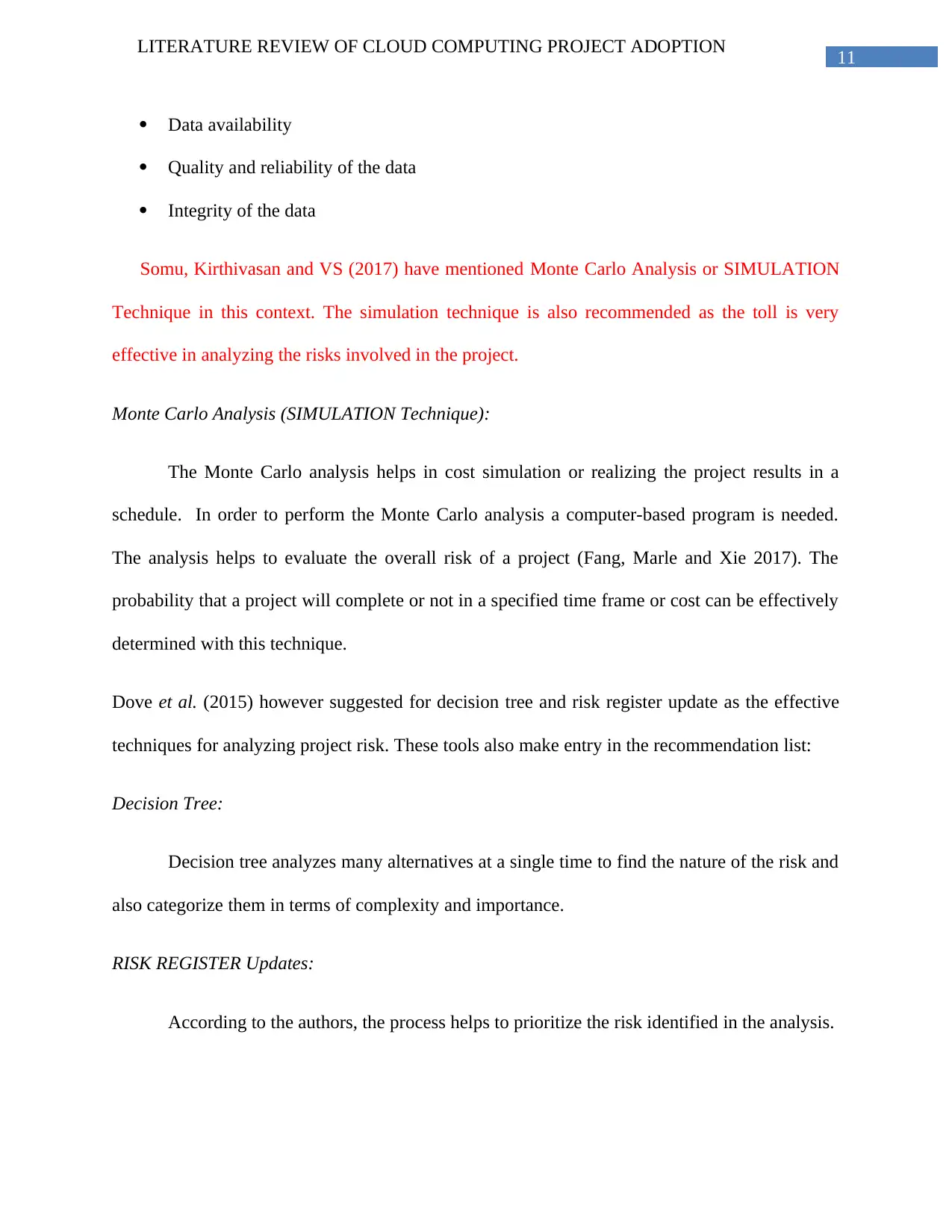
11
LITERATURE REVIEW OF CLOUD COMPUTING PROJECT ADOPTION
Data availability
Quality and reliability of the data
Integrity of the data
Somu, Kirthivasan and VS (2017) have mentioned Monte Carlo Analysis or SIMULATION
Technique in this context. The simulation technique is also recommended as the toll is very
effective in analyzing the risks involved in the project.
Monte Carlo Analysis (SIMULATION Technique):
The Monte Carlo analysis helps in cost simulation or realizing the project results in a
schedule. In order to perform the Monte Carlo analysis a computer-based program is needed.
The analysis helps to evaluate the overall risk of a project (Fang, Marle and Xie 2017). The
probability that a project will complete or not in a specified time frame or cost can be effectively
determined with this technique.
Dove et al. (2015) however suggested for decision tree and risk register update as the effective
techniques for analyzing project risk. These tools also make entry in the recommendation list:
Decision Tree:
Decision tree analyzes many alternatives at a single time to find the nature of the risk and
also categorize them in terms of complexity and importance.
RISK REGISTER Updates:
According to the authors, the process helps to prioritize the risk identified in the analysis.
LITERATURE REVIEW OF CLOUD COMPUTING PROJECT ADOPTION
Data availability
Quality and reliability of the data
Integrity of the data
Somu, Kirthivasan and VS (2017) have mentioned Monte Carlo Analysis or SIMULATION
Technique in this context. The simulation technique is also recommended as the toll is very
effective in analyzing the risks involved in the project.
Monte Carlo Analysis (SIMULATION Technique):
The Monte Carlo analysis helps in cost simulation or realizing the project results in a
schedule. In order to perform the Monte Carlo analysis a computer-based program is needed.
The analysis helps to evaluate the overall risk of a project (Fang, Marle and Xie 2017). The
probability that a project will complete or not in a specified time frame or cost can be effectively
determined with this technique.
Dove et al. (2015) however suggested for decision tree and risk register update as the effective
techniques for analyzing project risk. These tools also make entry in the recommendation list:
Decision Tree:
Decision tree analyzes many alternatives at a single time to find the nature of the risk and
also categorize them in terms of complexity and importance.
RISK REGISTER Updates:
According to the authors, the process helps to prioritize the risk identified in the analysis.
⊘ This is a preview!⊘
Do you want full access?
Subscribe today to unlock all pages.

Trusted by 1+ million students worldwide
1 out of 16
Related Documents
Your All-in-One AI-Powered Toolkit for Academic Success.
+13062052269
info@desklib.com
Available 24*7 on WhatsApp / Email
![[object Object]](/_next/static/media/star-bottom.7253800d.svg)
Unlock your academic potential
Copyright © 2020–2025 A2Z Services. All Rights Reserved. Developed and managed by ZUCOL.





